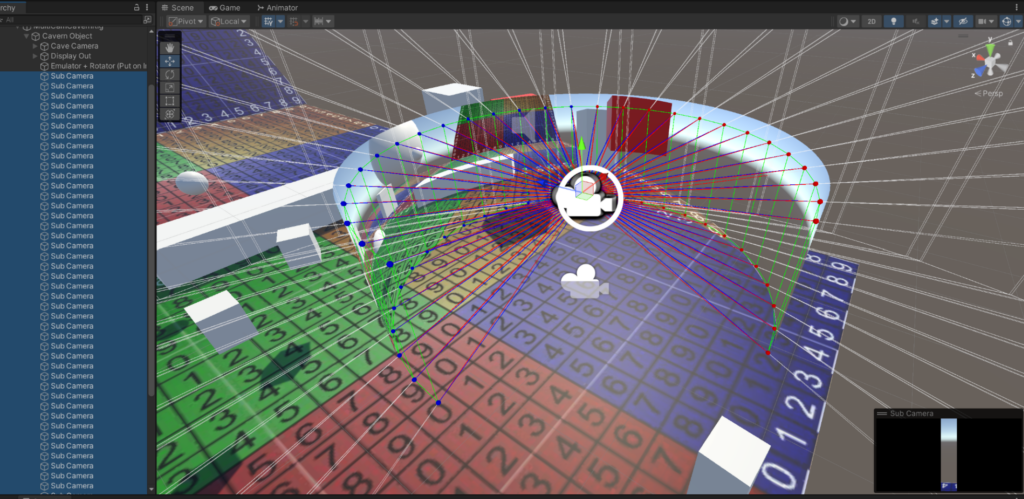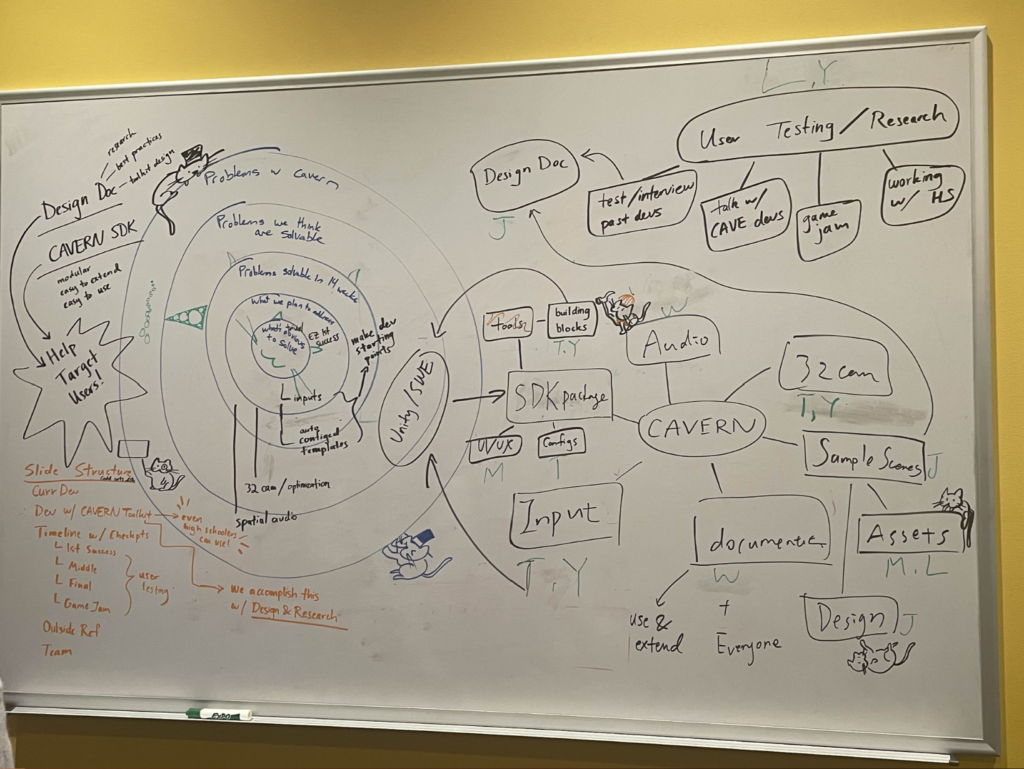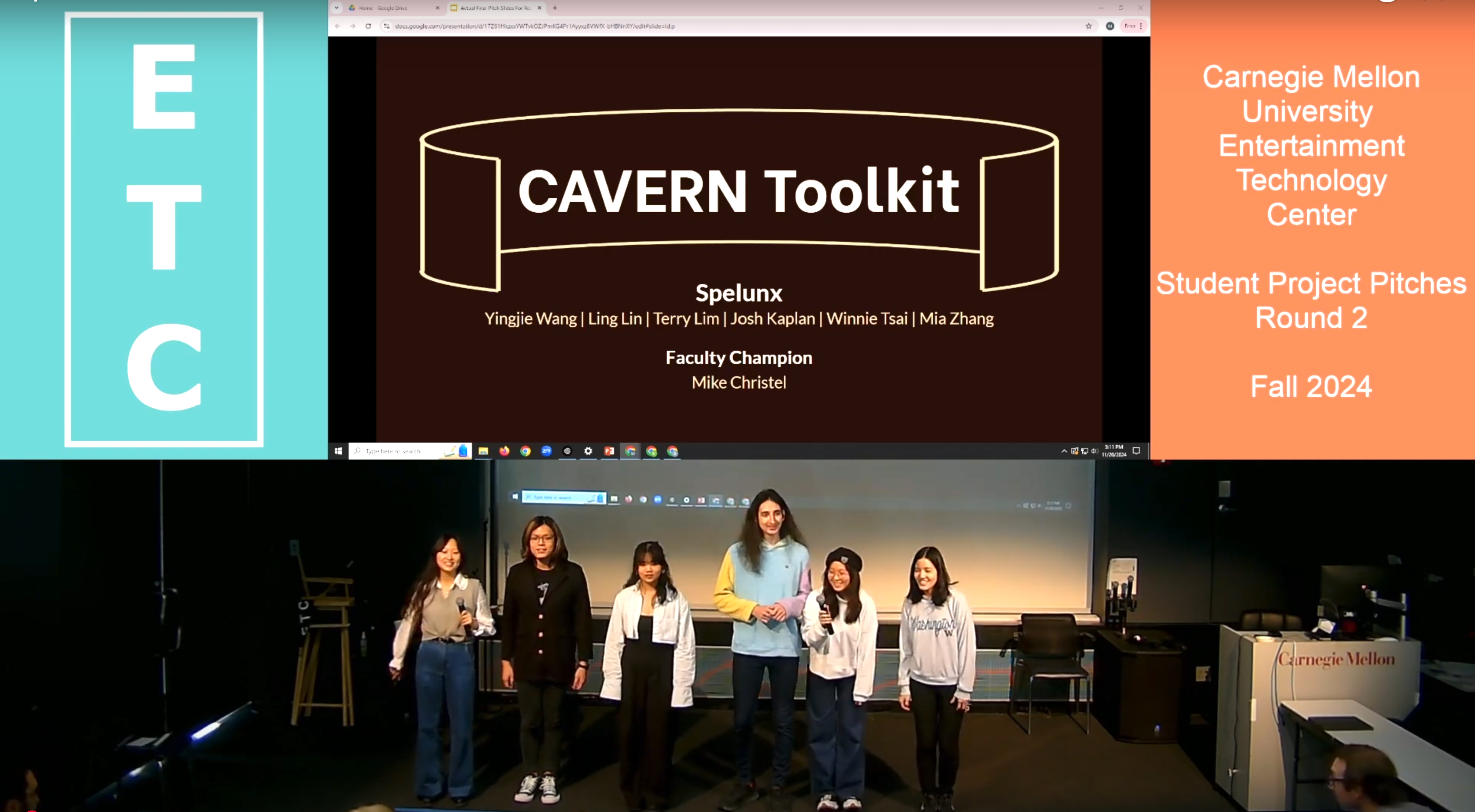Spelunx began as a technical passion project—four programmers eager to dive deep into rendering, software engineering, and systems development. We wanted to build something from scratch, not just another experience, but tools that would empower future creators.
Each of us had a different motivation for starting this project:
- Terri was drawn to optimizing software systems. She was especially interested in digging into the mathematics behind rendering code.
- Yingjie was passionate about human-centered design, particularly in how development tools could be structured to fit into creative pipelines.
- Winnie was interested in technical problem-solving with real impact, especially in documentation and tutorials. Also, she is interested in audio design and its immersive impact.
- Josh wanted to develop tools that enable creativity, focusing on the intersection of human-computer interaction and deeply technical math-heavy systems.
To better understand how to structure a technical project within ETC, with the help of faculty member Phil Light, we reached out to alumni from Isetta Engine, a past team that built a game engine from scratch. They shared insights into scoping technical work, balancing research with production, and making tools that are actually usable.
We were also connected with Cort Stratton, an ETC alum at Unity, whose expertise in real-time rendering and graphics programming helped us explore possible areas of focus. But what we needed was a platform that would challenge us technically while having real-world impact—which led us to CAVERN.
Discovering CAVERN
CAVERN is a 270-degree projection-based stereoscopic immersive space with a 20-foot play area. Unlike similar high-end virtual production or immersive projection systems on the market, CAVERN was built by Steve Audia as a cost-effective solution (millions vs. $20,000), making it affordable enough for educational institutions like high schools to implement. This makes CAVERN uniquely accessible, allowing students and educators to explore large-scale immersive environments without requiring the multi-million-dollar setups used in industry.
However, with this accessibility comes a unique set of challenges. Because CAVERN is a custom-built system, its technical setup requires careful configuration, including projection alignment, stereo warping, and input tracking. While this modularity makes it highly customizable, it also means that developers must manually integrate various components rather than relying on an out-of-the-box solution. Additionally, since each team working in CAVERN has historically developed its own workflow, past solutions are not always well-documented or standardized, leading to a learning curve for new users.
To learn more, we met with Steve, and he walked us through the system’s capabilities and pain points. Every semester, teams working in CAVERN struggled with:
- Cumbersome setup processes – Installing dependencies, configuring software, and troubleshooting setup delays.
- A lack of standardized tools – Every team had to engineer custom solutions for rendering, tracking, and input.
- Rendering and camera limitations – Standard Unity camera setups didn’t work properly in the space, and the current solution is costly in performance, severely limiting art fidelity.
- No clear documentation – Each new team reinvented solutions from scratch instead of building on past work. Worse yet, teams graduate and leave with their knowledge.
It became clear that CAVERN had enormous creative potential, but its usability barriers prevented it from being fully realized. This was the perfect challenge—a deeply technical problem that needed solving, with real impact for future ETC teams and beyond.
At this point, Ling joined our team, drawn to the opportunity to work alongside a technically focused group while developing her skills in environmental art and technical art. Shortly after, Mia, a second-year student with experience on two previous CAVERN projects, joined us as well, bringing valuable insights from past development efforts. With a well-rounded team and a clear technical challenge, Spelunx was born.
Researching the Problem – Past Teams & Expert Feedback
With CAVERN as our focus, we started by interviewing past teams, especially the Hycave project that used Unity and the Flow project that used Unreal Engine, to understand exactly what was missing from the development workflow. Across multiple projects, we heard the same frustrations:
- Input system incompatibility – Vive trackers and other input devices were difficult to integrate.
- Unclear technical constraints – Teams weren’t sure what art, shaders, and post-processing would actually work.
- Lack of testing flexibility – Testing required physical access to CAVERN, making iteration slow.
- No documentation of past solutions – Every project started from zero, even when previous teams had solved similar problems.

At this stage, Mike Christel, our faculty champion, played a crucial role in guiding our project direction. He helped us refine our focus, ensuring that our work would lead not only to a usable final product but also to a meaningful journey of exploration and discovery for each team member, regardless of background or expertise. Through conversations with nearly all faculty, we received valuable feedback that encouraged us to think beyond technical challenges and consider how our tool design could uncover novel insights into experience design within an immersive platform, and this led to our final pitch direction.
Pitching Our Project
At the ETC, pitch projects go through two rounds of approval before being officially greenlit. This process ensures that projects are well-defined, have clear goals, and are feasible within a semester. Faculty aren’t just looking for interesting ideas—they want to see a structured plan for execution and real-world impact.
With our research in hand, we structured our pitch around two key ideas:
- CAVERN has untapped creative potential, but technical barriers make it difficult to develop for.
- A structured, modular toolkit will make CAVERN more accessible, enabling both novice and experienced developers to create immersive experiences.
We presented a two-pronged approach:
- Technical Setup & Configuration – Solving rendering, input tracking, and audio challenges.
- Documentation & Templates – Providing structured tutorials and best practices to help new teams onboard quickly.
We made it very clear that our project was not just solving technical hurdles, but a user-centric project rooted in research, documentation, tutorials and testing.

To further validate our approach, we reached out to potential toolkit users. South Fayette High School’s was especially excited about the prospect of using Spelunx, as they are running a game design course this semester with the hope of developing experiences on their newly built CAVERN. This reinforced that this toolkit wasn’t just about ETC—it could also support young creators in learning interactive development.
After multiple iterations, faculty feedback, and refining our deliverables, Spelunx was officially approved as an ETC project.
Looking Ahead – Week 1 and Beyond

With our pitch behind us, we entered Week 1, focusing on:
- Meeting with stakeholders (faculty, South Fayette, and technical advisors).
- Defining our development roadmap to keep scope manageable.
- Setting up core tools like version control and documentation systems.
Spelunx started as a technical curiosity—an interest in pushing boundaries in graphics, software engineering, and development tools—but through research, team expansion, and faculty feedback, it became a well-defined project with a clear purpose. Now, it’s time to bring that vision to life.
Stay tuned for Week 1 updates!

